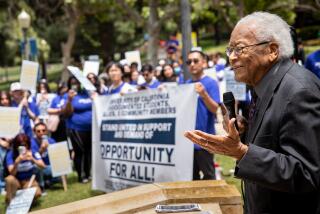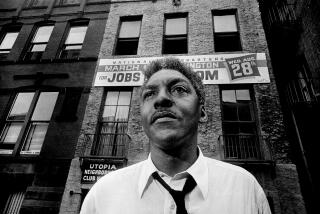Op-Ed: Watts 1965: Riot or revolt?
“The rioters were burning the city now, as the insane sometimes mutilate themselves,” wrote a Los Angeles Times reporter on Aug. 15, 1965.
“People keep calling it a riot,” Tommy Jacquette told the paper in 2005, “but we call it a revolt because it had a legitimate purpose.”
Both the reporter and Jacquette were eyewitnesses to the same civic disturbance in Watts 50 years ago — six violent days that left 34 people dead and thousands injured. But the distance between their two viewpoints is as wide as the 110 Freeway is long, and speaks to an enduring disagreement about what happened in South Los Angeles that August: Was it unbridled, angry chaos, or was it a purposeful response to oppression? Was it a riot or a revolt?
Quite clearly, the answer to this question depends in part on the personal and political experiences of the person doing the defining.
Hence the majority-white McCone Commission advanced an image of Watts protesters as opportunity-seizing riffraff, without much ideological motivation.
“The rioters seemed to have been caught up in an insensate rage of destruction,” the 1965 report states. It includes the word “riot” nearly 100 times, while the words “uprising” and “rebellion” are absent.
Tellingly, the most frequent use of the word “protest” comes from one of the two African Americans on the commission, the Rev. James Edward Jones, who uses it four times in one paragraph of dissent to parts of the commission’s findings.
Those six days had elements of both riot and revolt, chaos and protest, but 50 years later, it’s “riot” that seems to fall short of the mark.
It’s common to think of riots as spontaneous moments of mayhem. A fancy TV on sale on Black Friday might spark a small riot at a Wal-Mart. The defeat of a beloved sports team causes fans to riot in the streets. A rebellion, on the other hand, is an event in response to a specific political reality. Rebellions from Stonewall to Attica have included riot-like behavior, but their political undertones help shape how we think about them.
In 1965, Watts residents had plenty to rebel against. Just one year earlier, voters in California passed Proposition 14, which repealed the Rumford Fair Housing Act and legitimized housing segregation. A large number of residents interviewed by the McCone Commission complained of substandard housing, unemployment and exploitative local business practices. The passage of Proposition 14 meant they had even fewer avenues to escape these conditions. It was a state-sanctioned message to residents of ghettos to stay in their place. The events in Watts were a defiant rejoinder.
Distrust of the police, a grievance expressed by many McCone Commission interviewees, was also in play that first night in Watts. A California Highway Patrol officer pulled over Marquette Frye, a black man, on suspicion of drunken driving, and soon a crowd gathered to complain about the officer’s actions.
“I remember that they took him and threw him in the car like a bag of laundry and kicked his feet in and slammed the door,” Lacine Holland, an eyewitness, told The Times.
Residents threw bottles, bricks and rocks at police cars after Frye was arrested. On subsequent nights they targeted white-owned businesses in their community, the same businesses that interviewees told the commission marked up goods, sold rotten groceries and were hostile to black customers.
Many black-owned businesses, meanwhile, avoided the violence by putting up “blood brother” signs in their windows, indicating their solidarity with the demonstrators. This fact, coupled with the large number of residential properties and public spaces like parks and pools that were left untouched, suggests that participants in the Watts events were, after a fashion, disciplined and focused.
Of course, not everyone who took to the streets in Watts had a common political agenda, nor did they all follow the same code of conduct. In an event that included anywhere between 10,000 and 30,000 participants over a six-day span, there were many of pockets of deviation.
“It wasn’t military-level organization,” says Darnell Hunt, a professor of sociology at UCLA who studies civil unrest. “But there were critical masses of people who were focused and targeted on their goal.”
The goal itself is tougher to parse, which is no doubt another reason many write Watts off as a riot, plain and simple. We think of revolts as moments that might begin with violence but end in concrete civic change. Or if they do not, we expect the rebels to at least make clear their demands so we can assess their value or reasonableness.
In 1965 there was no manifesto. Still, it’s possible the demonstrators got some of what they wanted. Nearly a year after the disturbance, civil rights leader Bayard Rustin wrote about his trip to Watts for Commentary magazine:
“At a street-corner meeting in Watts when the riots were over, an unemployed youth of about 20 said to me, ‘We won.’ I asked him: ‘How have you won? Homes have been destroyed, Negroes are lying dead in the streets, the stores from which you buy food and clothes are destroyed, and people are bringing you relief.’ His reply was significant: ‘We won because we made the whole world pay attention to us.’”
Fifty years later, we should still be paying attention.
Angela Flournoy was raised in Southern California. She is the author of “The Turner House,” a novel.
Follow the Opinion section on Twitter @latimesopinion and Facebook
More to Read
A cure for the common opinion
Get thought-provoking perspectives with our weekly newsletter.
You may occasionally receive promotional content from the Los Angeles Times.






